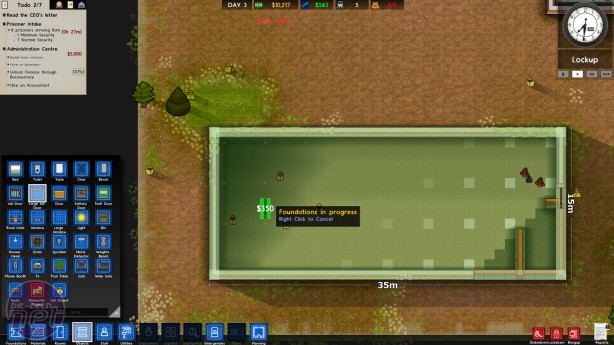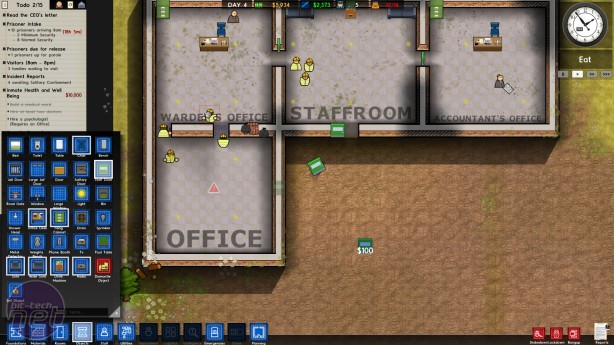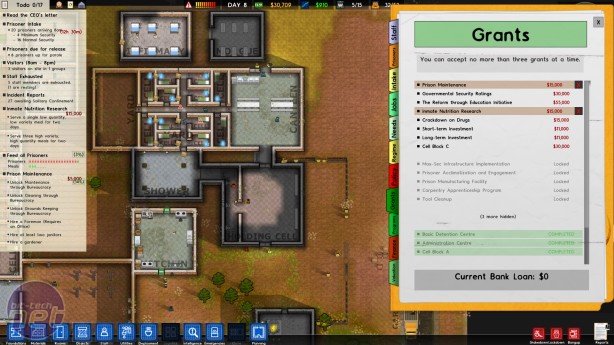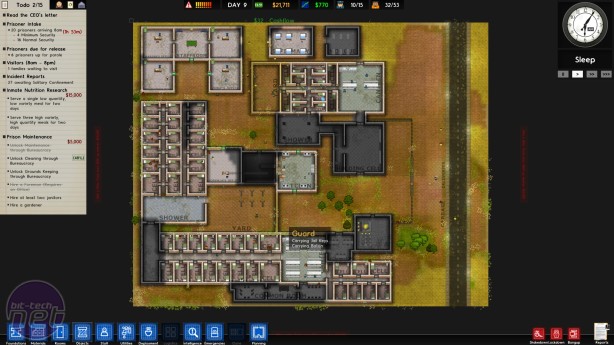
Ultimately though, the campaign is just an appetiser. The main bulk of Prison Architect is in constructing your own incarceration station, while also juggling finances and trying to squeeze in the latest influx of prisoners without completely obliterating their quality of life. To make things more complicated, your actions in-game are not immediately resolved. When constructing a new room, say, a canteen, you must first plot out the building's foundations, which are laid manually by teams of workmen. After this you specify the room type and denote the objects the room requires, which again must be collected and installed by your workmen. Lastly, you need to ensure the room is supplied by water and electricity by laying out cables and pipelines.
All of this takes time, and in the meantime your prisoners have nowhere to eat. A hungry prisoner is an angry prisoner, and that is a Very Bad Thing.
It's this delay between action and resolution that makes Prison Architect such an intriguing puzzle. You will often gasp in horror as you realise you need a new building RIGHT NOW to stop a full-on riot, knowing full-well that it will take at least a day to construct. Satisfying your prisoners' needs won't immediately quell their protests either, so you may have to resort to more forceful means in order to settle things down.
Even finance involves delayed gratification. Initially, your main source of income is through "grants" which pay you money provided your prison meets certain requirements, and often come with an advance payment. What usually happens is you use money from a new grant to finish off an old grant project, and use the money from your following grant to finish off the new grant project.
Throughout playing Prison Architect, your brain is constantly hopping several steps forward and several steps back, and it's a surprisingly satisfying mental exercise. Of course, there are moments when your brain trips over, and your prison spirals out of control. You might not even know it. On the surface it may appear like everything is fine. But a search of a cell block might reveal enough contraband in your prisoner's cells to equip a small army, or that your control over your prisoners has literally been undermined by a network of escape tunnels. Occasionally the game throws a curveball directly at you in the form of the Mayor, who will announce some ridiculous policy in response to political pressure, and fine you if you fail to enforce it.
This is where Prison Architect begins to spool out its stories. But they are very much stories about events rather than people. All your prisoners are individually simulated, and they all have different traits and backgrounds. Unfortunately, keeping track of individual inmates is next to impossible because so much else is going on. Consequently, those personalities fade into the background, only revealing themselves through explosive violence or daring escape attempts.
I don't think this is accidental. Prison Architect is an entertaining game, but its subject matter is inescapably grim, and the blow is only slightly softened by the cartoonish aesthetic. As you strive for a bigger prison that brings in more profit, the individuals who populate it become neglected, perhaps the same kind of social neglect that led them to this dire situation in the first place. Prison Architect never tackles the general sadness and occasional horror of prison life directly, but its systems never quite lets you forget the reality of prison life either. It's a tricky balancing act, and Introversion navigates it extremely well.
The release version of Prison Architect also introduces a new way to play. Escape mode lets you load up any prison you've built, or one which you've downloaded from the Steam Workshop, and play as a single inmate attempting to escape. This transforms Prison Architect from management sim into RPG. You scour the prison for weapons and equipment, attempt to stash them in safe places, spend upgrade points to increase your character's toughness or strength, and gain influence by causing fights, which you can use to recruit people to your cause and minimise time in confinement if you're caught. It's a fun distraction from the management side, although I doubt it's likely to hold your attention for too long.
Overall, Prison Architect is an extremely well put together game. However, it still suffers from the odd bug which, given the granularity of the simulation, can cause much bigger problems in your prison. In my current game, a jail door leading to a cell wing became stuck. It wouldn't open and I couldn't remove it, meaning that part of the prison was effectively sealed off until I could build an alternative entrance. Luckily, the wing was newly constructed and had yet to house any prisoners. But it's the kind of little glitch that could have resulted in a full-blown prison riot.
In a way this is a testament to the quality of the simulation. These small errors and oversights have a profound effect on your prison, and it's that ethos which underpins the entire game. It's annoying when those mistakes are the game's rather than your own, but such instances are few and far between. For the most part, it's you who will be making the mistakes that stoke misery and ignite revolution within your prison walls, from minor omissions to utterly boneheaded decisions. I expect you will find something to enjoy in every one, even if your prisoners don't.
All of this takes time, and in the meantime your prisoners have nowhere to eat. A hungry prisoner is an angry prisoner, and that is a Very Bad Thing.
It's this delay between action and resolution that makes Prison Architect such an intriguing puzzle. You will often gasp in horror as you realise you need a new building RIGHT NOW to stop a full-on riot, knowing full-well that it will take at least a day to construct. Satisfying your prisoners' needs won't immediately quell their protests either, so you may have to resort to more forceful means in order to settle things down.
Even finance involves delayed gratification. Initially, your main source of income is through "grants" which pay you money provided your prison meets certain requirements, and often come with an advance payment. What usually happens is you use money from a new grant to finish off an old grant project, and use the money from your following grant to finish off the new grant project.
Throughout playing Prison Architect, your brain is constantly hopping several steps forward and several steps back, and it's a surprisingly satisfying mental exercise. Of course, there are moments when your brain trips over, and your prison spirals out of control. You might not even know it. On the surface it may appear like everything is fine. But a search of a cell block might reveal enough contraband in your prisoner's cells to equip a small army, or that your control over your prisoners has literally been undermined by a network of escape tunnels. Occasionally the game throws a curveball directly at you in the form of the Mayor, who will announce some ridiculous policy in response to political pressure, and fine you if you fail to enforce it.
This is where Prison Architect begins to spool out its stories. But they are very much stories about events rather than people. All your prisoners are individually simulated, and they all have different traits and backgrounds. Unfortunately, keeping track of individual inmates is next to impossible because so much else is going on. Consequently, those personalities fade into the background, only revealing themselves through explosive violence or daring escape attempts.
I don't think this is accidental. Prison Architect is an entertaining game, but its subject matter is inescapably grim, and the blow is only slightly softened by the cartoonish aesthetic. As you strive for a bigger prison that brings in more profit, the individuals who populate it become neglected, perhaps the same kind of social neglect that led them to this dire situation in the first place. Prison Architect never tackles the general sadness and occasional horror of prison life directly, but its systems never quite lets you forget the reality of prison life either. It's a tricky balancing act, and Introversion navigates it extremely well.
The release version of Prison Architect also introduces a new way to play. Escape mode lets you load up any prison you've built, or one which you've downloaded from the Steam Workshop, and play as a single inmate attempting to escape. This transforms Prison Architect from management sim into RPG. You scour the prison for weapons and equipment, attempt to stash them in safe places, spend upgrade points to increase your character's toughness or strength, and gain influence by causing fights, which you can use to recruit people to your cause and minimise time in confinement if you're caught. It's a fun distraction from the management side, although I doubt it's likely to hold your attention for too long.
Overall, Prison Architect is an extremely well put together game. However, it still suffers from the odd bug which, given the granularity of the simulation, can cause much bigger problems in your prison. In my current game, a jail door leading to a cell wing became stuck. It wouldn't open and I couldn't remove it, meaning that part of the prison was effectively sealed off until I could build an alternative entrance. Luckily, the wing was newly constructed and had yet to house any prisoners. But it's the kind of little glitch that could have resulted in a full-blown prison riot.
In a way this is a testament to the quality of the simulation. These small errors and oversights have a profound effect on your prison, and it's that ethos which underpins the entire game. It's annoying when those mistakes are the game's rather than your own, but such instances are few and far between. For the most part, it's you who will be making the mistakes that stoke misery and ignite revolution within your prison walls, from minor omissions to utterly boneheaded decisions. I expect you will find something to enjoy in every one, even if your prisoners don't.
-
Overall85 / 100


MSI MPG Velox 100R Chassis Review
October 14 2021 | 15:04













Want to comment? Please log in.